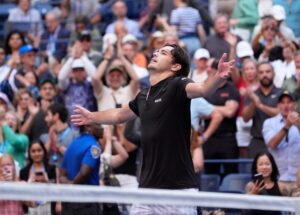Continuing our series on 1968: The Year That Changed Tennis, Martin Keady, our resident tennis historian, looks back at Wimbledon ’68: the first Open Wimbledon.
In one respect, Wimbledon had it easy compared to the three other tennis Majors when it came to adapting to the Open era that began in 1968. Unlike the other Majors, which went from being the Australian, French and US Championships to the Australian, French and US Opens, Wimbledon did not have to change its name, as its official title has always been simply “The Championships” (the definite article showing how it has always regarded itself as the definitive tennis tournament). In other respects, however, Wimbledon had to make greater changes than the other Majors to make the transition from the end of the amateur era to the beginning of fully professional, or “Open,” tennis.
The word “Open” may not have been incorporated into Wimbledon’s title, but it is integral to understanding the historic change that happened in tennis in 1968, not least at Wimbledon itself. It was used to signal the end of the old, secretive or “closed” era in the history of tennis. That era had lasted from the end of the 19th century, when the rules of tennis (a sport that had existed in many different forms in many different countries from the 12th century onwards) were first properly codified by the British, right up until the 1960s.
There had been professional tennis players since the 1920s, when Suzanne Lenglen of France and America’s Bill Tilden, the first true tennis superstars, did so much to popularise tennis on both sides of the Atlantic. However, players who wanted to become professional and actually make their living from the game they played had to forego the right to compete in the sport’s biggest events, the Majors.
That situation had always been contentious, particularly because tennis was the last major sport to turn professional. (Only rugby union remained an amateur sport for longer, finally becoming fully professional in the 1990s, but it did not have the truly global appeal of tennis.) However, by the mid-1960s it was absolutely ludicrous, as the best tennis players in the world, including the already legendary Rod Laver, were being denied the chance to compete in the sport’s greatest events.
What compounded the situation was the fact that so many of the players who had supposedly remained amateur, so that they could continue to participate in the Grand Slam tournaments, were at best “shamateur”, as the popular phrase of the time had it. That was because they were already surreptitiously receiving appearance money from some events and even sponsorship money from racket and kit manufacturers.
All four of the Majors recognised the problem, but ironically it was Wimbledon – supposedly the most hidebound of them all, as the traditional “guardian” of the ancient values of tennis (including the commitment to amateurism) – that made the decisive move. In December 1967, the Lawn Tennis Association, which was and remains the governing body of tennis in Britain, took a historic vote among its members to decide whether or not to allow professional players to compete in the following year’s tournament. The result was a landslide – 295 to 5 – in favour of allowing the professionals, like Laver, to play. Thus, the stage was set for the entry of professional players to Wimbledon in 1968 – or rather the re-entry, as so many of them, like Laver, had competed in the tournament before they had turned professional.
The tennis calendar in 1968 was very different to what it is today. For one thing, the Australian Open took place at the end of the season rather than at the start, meaning it was the 1968 French Open that became the first Open-era Major (https://lastwordontennis.com/2018/05/18/paris-68-the-first-major-of-the-open-era/). Nevertheless, given Wimbledon’s status as the pre-eminent tennis tournament – the first among equals of all four Majors – there was great interest at the time in seeing how “The Championships” would become “The Open Championships”, even if it was not renamed as such.
The 1968 French Open had been played out against the backdrop of a genuine revolution, as French students and workers took to the streets of Paris to protest against what they regarded as a reactionary and backwards-looking Government. By complete contrast, the British Pathé News reels at the time (which continued to be made up until 1970 and the widespread adoption by the British public of television news as its main source of news and information) seemed to show that nothing much had changed at Wimbledon. They continued to focus on the attire of female patrons and of course the vagaries of the British weather, which necessitated numerous coverings of the main courts from rain.
However, even if outwardly Wimbledon ’68 was little different to Wimbledon ’67, especially as far as the fans were concerned, for the players themselves things were very different. Most importantly, the best players in the world were now free to play in the world’s greatest tennis tournament and they no longer had to play for free to do so.
Among those making a return to Wimbledon after several years away (years spent largely on the various professional circuits and exhibition series of North America) were the great Australian trio of Lew Hoad, Ken Rosewall and, of course, Rod Laver. All three had been absent from Wimbledon and the other Majors for between five and ten years, but now they were free to return and compete against each other again on the sport’s greatest stage.
Fittingly, it was Laver, the greatest male tennis player of his era (and in the opinion of many the greatest male tennis player ever) who was the winner of the first Open Wimbledon, defeating his compatriot Tony Roche in the final in straight sets (6–3, 6–4, 6–2). It was fitting because before he turned professional in 1963 Laver had won the actual Grand Slam – i.e. all four Majors in one calendar year – in 1962, becoming the first man to do so since America’s Don Budge in 1938.
However, because Laver had then turned professional (to add some fortune to his burgeoning global fame), he had been denied entry to the Majors for fully half a decade. As a result, just as boxing writers often claim that the best boxer ever never actually entered the ring (because Muhammad Ali was banned from boxing between 1967 and 1970, which would have been his peak years, for refusing to be drafted into the US military during the Vietnam war), so tennis writers often argue that the best tennis player ever never competed in the sport’s greatest events (because Laver, at his own physical peak, was not allowed to compete in the Majors).
Laver’s conquest of Wimbledon in 1968 was the beginning of his remarkable late period of greatness, which culminated in his winning the calendar Grand Slam again in 1969. His historic achievement in 1969 made him the only man in tennis history to win the calendar Grand Slam twice and also the only man to do it as both an amateur and a professional, a feat that will never be repeated now that tennis is a truly “Open” sport.
However, it was not only on the men’s side of the game that the impact of tennis finally becoming “Open” was felt. Billie Jean King did not have to make the transition that Rod Laver did between the amateur and Open eras of tennis, because she had remained an amateur until 1968 and then seamlessly switched to becoming a full professional. Nevertheless, Wimbledon ’68, which she won to complete a hat-trick of three successive Wimbledon singles titles, also marked the beginning of her own long campaign to secure equal status and prize money for female tennis players.
That was because the winner of the men’s singles title in 1968 earned more than twice as much as the winner of the women’s singles title – £2,000 compared with £750. Although tennis had finally become an “Open” sport, it still obviously remained a gender-unequal sport. That fact provided King with all the incentive she needed to launch her long campaign for equal prize money and status for men and women. It would finally reach fruition in 1973, when she not only defeated Bobby Riggs in the famous “Battle of the Sexes” exhibition match but far more importantly founded the Women’s Tennis Association.
1973 was also the year when male tennis players finally flexed their muscles. First, they formed the Association of Tennis Players and then they organised a mass boycott of Wimbledon in support of Niki Pilić, the Yugoslav player who had been banned from appearing in SW19 because he had refused to play in a Davis Cup match for his country against New Zealand earlier that year.
However, 1973, which probably ranks as the second most important year in the history of tennis (certainly professional tennis) after 1968, was still five years away when the first Open-era Wimbledon was played. In 1968, the likes of King and Pilić were still exclusively tennis players, rather than the player-campaigners they would later become. Nevertheless, with the benefit of hindsight, it is evident that the seeds of the 1970s tennis revolution, during which tennis would not only become fully professional but fabulously lucrative (at least for its top players), were first sewn in 1968, including on the ancient grass of Wimbledon.
Others in this series
Brief History of Pre-1968 Tennis
1968: The Year that Changed Tennis
1968 French Open
1968 US Open
Main Photo:
Embed from Getty Images






